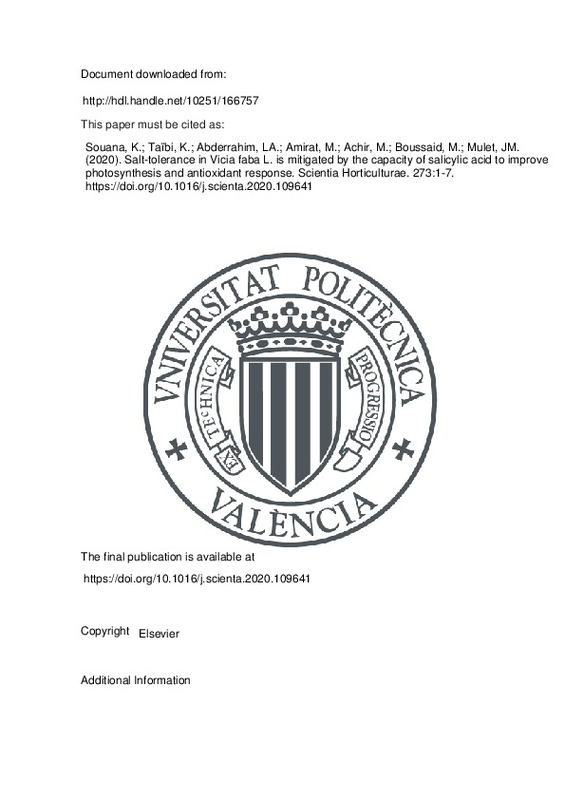Ahmad, P., Alyemeni, M. N., Ahanger, M. A., Egamberdieva, D., Wijaya, L., & Alam, P. (2018). Salicylic Acid (SA) Induced Alterations in Growth, Biochemical Attributes and Antioxidant Enzyme Activity in Faba Bean (Vicia faba L.) Seedlings under NaCl Toxicity. Russian Journal of Plant Physiology, 65(1), 104-114. doi:10.1134/s1021443718010132
Almeida, D. M., Oliveira, M. M., & Saibo, N. J. M. (2017). Regulation of Na+ and K+ homeostasis in plants: towards improved salt stress tolerance in crop plants. Genetics and Molecular Biology, 40(1 suppl 1), 326-345. doi:10.1590/1678-4685-gmb-2016-0106
Ashraf, M., & Harris, P. J. C. (2013). Photosynthesis under stressful environments: An overview. Photosynthetica, 51(2), 163-190. doi:10.1007/s11099-013-0021-6
[+]
Ahmad, P., Alyemeni, M. N., Ahanger, M. A., Egamberdieva, D., Wijaya, L., & Alam, P. (2018). Salicylic Acid (SA) Induced Alterations in Growth, Biochemical Attributes and Antioxidant Enzyme Activity in Faba Bean (Vicia faba L.) Seedlings under NaCl Toxicity. Russian Journal of Plant Physiology, 65(1), 104-114. doi:10.1134/s1021443718010132
Almeida, D. M., Oliveira, M. M., & Saibo, N. J. M. (2017). Regulation of Na+ and K+ homeostasis in plants: towards improved salt stress tolerance in crop plants. Genetics and Molecular Biology, 40(1 suppl 1), 326-345. doi:10.1590/1678-4685-gmb-2016-0106
Ashraf, M., & Harris, P. J. C. (2013). Photosynthesis under stressful environments: An overview. Photosynthetica, 51(2), 163-190. doi:10.1007/s11099-013-0021-6
Bulut, F., Akıncı, Ş., & Eroğlu, A. (2011). Growth and Uptake of Sodium and Potassium in Broad Bean (Vicia fabaL.) under Salinity Stress. Communications in Soil Science and Plant Analysis, 42(8), 945-961. doi:10.1080/00103624.2011.558963
Csiszár, J., Horváth, E., Váry, Z., Gallé, Á., Bela, K., Brunner, S., & Tari, I. (2014). Glutathione transferase supergene family in tomato: Salt stress-regulated expression of representative genes from distinct GST classes in plants primed with salicylic acid. Plant Physiology and Biochemistry, 78, 15-26. doi:10.1016/j.plaphy.2014.02.010
DEMIRAL, T., & TURKAN, I. (2005). Comparative lipid peroxidation, antioxidant defense systems and proline content in roots of two rice cultivars differing in salt tolerance. Environmental and Experimental Botany, 53(3), 247-257. doi:10.1016/j.envexpbot.2004.03.017
El-Tayeb, M. A. (2005). Response of barley grains to the interactive e.ect of salinity and salicylic acid. Plant Growth Regulation, 45(3), 215-224. doi:10.1007/s10725-005-4928-1
Hanin, M., Ebel, C., Ngom, M., Laplaze, L., & Masmoudi, K. (2016). New Insights on Plant Salt Tolerance Mechanisms and Their Potential Use for Breeding. Frontiers in Plant Science, 7. doi:10.3389/fpls.2016.01787
Hernández, J. A. (2019). Salinity Tolerance in Plants: Trends and Perspectives. International Journal of Molecular Sciences, 20(10), 2408. doi:10.3390/ijms20102408
Herrera-Vásquez, A., Salinas, P., & Holuigue, L. (2015). Salicylic acid and reactive oxygen species interplay in the transcriptional control of defense genes expression. Frontiers in Plant Science, 6. doi:10.3389/fpls.2015.00171
Isayenkov, S. V., & Maathuis, F. J. M. (2019). Plant Salinity Stress: Many Unanswered Questions Remain. Frontiers in Plant Science, 10. doi:10.3389/fpls.2019.00080
Jayakannan, M., Bose, J., Babourina, O., Rengel, Z., & Shabala, S. (2013). Salicylic acid improves salinity tolerance in Arabidopsis by restoring membrane potential and preventing salt-induced K+ loss via a GORK channel. Journal of Experimental Botany, 64(8), 2255-2268. doi:10.1093/jxb/ert085
Khan, M. I. R., Asgher, M., & Khan, N. A. (2014). Alleviation of salt-induced photosynthesis and growth inhibition by salicylic acid involves glycinebetaine and ethylene in mungbean (Vigna radiata L.). Plant Physiology and Biochemistry, 80, 67-74. doi:10.1016/j.plaphy.2014.03.026
Khan, M. I. R., Fatma, M., Per, T. S., Anjum, N. A., & Khan, N. A. (2015). Salicylic acid-induced abiotic stress tolerance and underlying mechanisms in plants. Frontiers in Plant Science, 6. doi:10.3389/fpls.2015.00462
Lawlor, D. W., & Cornic, G. (2002). Photosynthetic carbon assimilation and associated metabolism in relation to water deficits in higher plants. Plant, Cell & Environment, 25(2), 275-294. doi:10.1046/j.0016-8025.2001.00814.x
Li, L., Zhang, H., Zhang, L., Zhou, Y., Yang, R., Ding, C., & Wang, X. (2014). The physiological response of Artemisia annua L. to salt stress and salicylic acid treatment. Physiology and Molecular Biology of Plants, 20(2), 161-169. doi:10.1007/s12298-014-0228-4
Dionisio-Sese, M. L., & Tobita, S. (1998). Antioxidant responses of rice seedlings to salinity stress. Plant Science, 135(1), 1-9. doi:10.1016/s0168-9452(98)00025-9
Moussa, H. R., & Hassan, M. A. E.-F. (2015). Growth Enhancers to Mitigate Salinity Stress inVicia faba. International Journal of Vegetable Science, 22(3), 243-250. doi:10.1080/19315260.2015.1020585
Nazar, R., Umar, S., & Khan, N. A. (2015). Exogenous salicylic acid improves photosynthesis and growth through increase in ascorbate-glutathione metabolism and S assimilation in mustard under salt stress. Plant Signaling & Behavior, 10(3), e1003751. doi:10.1080/15592324.2014.1003751
Taïbi, K., Del Campo, A. D., Vilagrosa, A., Bellés, J. M., López-Gresa, M. P., López-Nicolás, J. M., & Mulet, J. M. (2018). Distinctive physiological and molecular responses to cold stress among cold-tolerant and cold-sensitive Pinus halepensis seed sources. BMC Plant Biology, 18(1). doi:10.1186/s12870-018-1464-5
Taïbi, K., del Campo, A. D., Vilagrosa, A., Bellés, J. M., López-Gresa, M. P., Pla, D., … Mulet, J. M. (2017). Drought Tolerance in Pinus halepensis Seed Sources As Identified by Distinctive Physiological and Molecular Markers. Frontiers in Plant Science, 8. doi:10.3389/fpls.2017.01202
Taïbi, K., Taïbi, F., Ait Abderrahim, L., Ennajah, A., Belkhodja, M., & Mulet, J. M. (2016). Effect of salt stress on growth, chlorophyll content, lipid peroxidation and antioxidant defence systems in Phaseolus vulgaris L. South African Journal of Botany, 105, 306-312. doi:10.1016/j.sajb.2016.03.011
Wu, J., Seliskar, D. M., & Gallagher, J. L. (1998). Stress tolerance in the marsh plant Spartina patens
: Impact of NaCl on growth and root plasma membrane lipid composition. Physiologia Plantarum, 102(2), 307-317. doi:10.1034/j.1399-3054.1998.1020219.x
Xu, E., & Brosché, M. (2014). Salicylic acid signaling inhibits apoplastic reactive oxygen species signaling. BMC Plant Biology, 14(1), 155. doi:10.1186/1471-2229-14-155
[-]







![[Cerrado]](/themes/UPV/images/candado.png)


